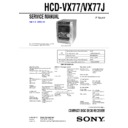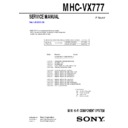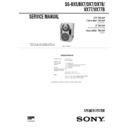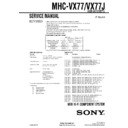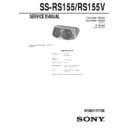Sony HCD-VX77J / MHC-VX77 / MHC-VX77J Service Manual ▷ View online
1
HCD-VX77/VX77J
SERVICE MANUAL
HCD-VX77/VX77J is the tuner, deck, CD and
amplifier section in MHC-VX77/VX77J.
amplifier section in MHC-VX77/VX77J.
SPECIFICATIONS
COMPACT DISC DECK RECEIVER
— Continued on next page —
Model Name Using Similar Mechanism
NEW
CD Mechanism Type
CDM58-K2BD37A
Base Unit Type
BU-K2BD37A
Optical Pick-up Type
KSM-213DAP
Model Name Using Similar Mechanism
NEW
Tape Transport Mechanism Type
TCM-230PWR11
CD
SECTION
TAPE DECK
SECTION
Photo: HCD-VX77
E Model
Amplifier section
The following measured at AC 120, 220, 240V
50/60 Hz
DIN power output (rated) 160 + 160 watts
50/60 Hz
DIN power output (rated) 160 + 160 watts
(6 ohms at 1 kHz, DIN)
Continuous RMS power output (reference)
200 + 200 watts
(6 ohms at 1 kHz,
10% THD)
(6 ohms at 1 kHz,
10% THD)
Inputs
MD/VIDEO (AUDIO) IN: voltage 450 mV/250 mV,
(phono jacks)
MD/VIDEO (AUDIO) IN: voltage 450 mV/250 mV,
(phono jacks)
impedance 47 kilohms
MIC:
sensitivity 1 mV,
(phone jack)
impedance 10 kilohms
Outputs
VIDEO OUT:
VIDEO OUT:
max. output level 1 Vp-p,
(Phono jack)
unbalanced, Sync
negative, load impedance
75 ohms
negative, load impedance
75 ohms
S-VIDEO OUT:
Y: 1 Vp-p, unbalanced
(4 pin/mini-DIN jack)
Sync negative
C: 0.286 Vp-p
load impedence 75 ohms
C: 0.286 Vp-p
load impedence 75 ohms
PHONES:
accepts headphones of 8
(stereo mini jack)
ohms or more
FRONT SPEAKER:
accepts impedance of 6 to
16 ohms
16 ohms
SURROUND SPEAKER: accepts impedance of
16 ohms
VIDEO CD/CD player section
System
Compact disc and digital
audio system
audio system
Laser
Semiconductor laser
(λ=780nm)
Emission duration:
continuous
(λ=780nm)
Emission duration:
continuous
Laser output
Max. 44.6 µW*
*This output is the value
measured at a distance of
200 mm from the
objective lens surface on
the Optical Pick-up Block
with 7 mm aperture.
*This output is the value
measured at a distance of
200 mm from the
objective lens surface on
the Optical Pick-up Block
with 7 mm aperture.
Frequency response
2 Hz – 20 kHz (±0.5 dB)
Wavelength
780 – 790 nm
Signal-to-noise ratio
More than 90 dB
Dynamic range
More than 90 dB
Video color system format
NTSC, PAL
CD OPTICAL DIGITAL OUT
(Square optical connector jack, rear panel)
Wavelength
(Square optical connector jack, rear panel)
Wavelength
660 nm
Output Level
–18 dBm
Tape player section
Recording system
4-track 2-channel stereo
Frequency response
40 – 13,000 Hz (±3 dB),
using Sony TYPE I
cassette
using Sony TYPE I
cassette
Tuner section
FM stereo, FM/AM superheterodyne tuner
FM tuner section
Tuning range
87.5 – 108.0 MHz
Antenna
FM lead antenna
Antenna terminals
75 ohm unbalanced
Intermediate frequency
10.7 MHz
AM tuner section
Tuning range
Middle Eastern models:
Middle Eastern models:
531 – 1,602 kHz
(with the interval set at 9
kHz)
(with the interval set at 9
kHz)
Other models:
531 – 1,602 kHz
(with the interval set at 9
kHz)
530 – 1,710 kHz
(with the interval set at 10
kHz)
(with the interval set at 9
kHz)
530 – 1,710 kHz
(with the interval set at 10
kHz)
Antenna
AM loop antenna
Antenna terminals
External antenna terminal
Intermediate frequency
450 kHz
9-929-223-13
2003L02-1
© 2003.12
Sony Corporation
Home Audio Company
Published by Sony Engineering Corporation
Ver 1.2 2003.12
2
General
Power requirements
Thailand models:
Thailand models:
220 V AC, 50/60 Hz
Other models:
120 V, 220 V or 230 - 240
V AC, 50/60 Hz
Adjustable with voltage
selector
V AC, 50/60 Hz
Adjustable with voltage
selector
Power consumption
250 watts
Dimensions (w/h/d)
Approx. 280 x 360 x 425
mm (11
mm (11
x 14
3
/
16
x 16
11
/
16
in.)
Mass:
Approx. 9.5 kg
(21 lb.)
(21 lb.)
Supplied accessories:
AM loop antenna (1)
Remote commander (1)
Batteries (2)
Video cable (1)
FM lead antenna (1)
Front speaker pads (8)
Remote commander (1)
Batteries (2)
Video cable (1)
FM lead antenna (1)
Front speaker pads (8)
Design and specifications are subject to change
without notice.
without notice.
TABLE OF CONTENTS
1. SERVICE NOTE
······························································· 4
2. GENERAL
·········································································· 5
3. DISASSEMBLY
································································ 7
4. TEST MODE
···································································· 12
5. MECHANICAL ADJUSTMENTS
····························· 17
6. ELECTRICAL ADJUSTMENTS
······························· 17
7. DIAGRAMS
7-1.
Circuit Board Location ····················································· 23
7-2.
Block Diagrams – TUNER/CD Section – ························ 25
7-3.
Printed Wiring Board – BD Section – ······························ 28
7-4.
Schematic Diagram – BD Section – ································· 29
7-5.
Printed Wiring Board – Video Section – ·························· 30
7-6.
Schematic Diagram – Video (1/3) Section – ···················· 31
7-7.
Schematic Diagram – Video (2/3) Section – ···················· 32
7-8.
Schematic Diagram – Video (3/3) Section – ···················· 33
7-9.
Printed Wiring Board – Main Section – ··························· 34
7-10. Schematic Diagram – Main (1/3) Section – ····················· 35
7-11. Schematic Diagram – Main (2/3) Section – ····················· 36
7-12. Schematic Diagram – Main (3/3) Section – ····················· 37
7-13. Printed Wiring Board – Power AMP Section – ················ 38
7-14. Schematic Diagram – Power AMP Section – ··················· 39
7-15. Printed Wiring Board – Panel Section – ··························· 40
7-16. Schematic Diagram – Panel Section – ····························· 41
7-17. Printed Wiring Board – Leaf SW Section – ····················· 42
7-18. Schematic Diagram – Leaf SW Section – ························ 43
7-19. Printed Wiring Board – Driver Section – ························· 44
7-20. Schematic Diagram – Driver Section – ···························· 45
7-21. Printed Wiring Board – Trans Section – ··························· 46
7-22. Schematic Diagram – Trans Section – ····························· 47
7-23. IC Pin Function ································································ 48
7-24. IC Block Diagrams ··························································· 57
7-11. Schematic Diagram – Main (2/3) Section – ····················· 36
7-12. Schematic Diagram – Main (3/3) Section – ····················· 37
7-13. Printed Wiring Board – Power AMP Section – ················ 38
7-14. Schematic Diagram – Power AMP Section – ··················· 39
7-15. Printed Wiring Board – Panel Section – ··························· 40
7-16. Schematic Diagram – Panel Section – ····························· 41
7-17. Printed Wiring Board – Leaf SW Section – ····················· 42
7-18. Schematic Diagram – Leaf SW Section – ························ 43
7-19. Printed Wiring Board – Driver Section – ························· 44
7-20. Schematic Diagram – Driver Section – ···························· 45
7-21. Printed Wiring Board – Trans Section – ··························· 46
7-22. Schematic Diagram – Trans Section – ····························· 47
7-23. IC Pin Function ································································ 48
7-24. IC Block Diagrams ··························································· 57
8. EXPLODED VIEWS
8-1.
Main Section ····································································· 61
8-2.
Panel Section ···································································· 62
8-3.
Main Board Section ·························································· 63
8-4.
Tape Mechanism Deck Section-1 ····································· 64
8-5.
Tape Mechanism Deck Section-2 ····································· 65
8-6.
CD Mechanism Deck Section (CDM58-K2BD37A) ······· 66
8-7.
Base Unit Section (BU-K2BD37A) ································· 67
9. ELECTRICAL PARTS LIST
······································· 68
Ver 1.1 2001.08
3
This appliance is classified as a CLASS 1 LASER product. The
CLASS 1 LASER PRODUCT MARKING is located on the rear
exterior.
CLASS 1 LASER PRODUCT MARKING is located on the rear
exterior.
Laser component in this product is capable
of emitting radiation exceeding the limit for
Class 1.
of emitting radiation exceeding the limit for
Class 1.
CAUTION
Use of controls or adjustments or performance of procedures
other than those specified herein may result in hazardous radiation
exposure.
Use of controls or adjustments or performance of procedures
other than those specified herein may result in hazardous radiation
exposure.
Notes on chip component replacement
• Never reuse a disconnected chip component.
• Notice that the minus side of a tantalum capacitor may be
• Never reuse a disconnected chip component.
• Notice that the minus side of a tantalum capacitor may be
damaged by heat.
Flexible Circuit Board Repairing
• Keep the temperature of soldering iron around 270˚C
• Keep the temperature of soldering iron around 270˚C
during repairing.
• Do not touch the soldering iron on the same conductor of the
circuit board (within 3 times).
• Be careful not to apply force on the conductor when soldering
or unsoldering.
NOTES ON HANDLING THE OPTICAL PICK-UP
BLOCK OR BASE UNIT
BLOCK OR BASE UNIT
The laser diode in the optical pick-up block may suffer electrostatic
break-down because of the potential difference generated by the
charged electrostatic load, etc. on clothing and the human body.
During repair, pay attention to electrostatic break-down and also
use the procedure in the printed matter which is included in the
repair parts.
The flexible board is easily damaged and should be handled with
care.
break-down because of the potential difference generated by the
charged electrostatic load, etc. on clothing and the human body.
During repair, pay attention to electrostatic break-down and also
use the procedure in the printed matter which is included in the
repair parts.
The flexible board is easily damaged and should be handled with
care.
NOTES ON LASER DIODE EMISSION CHECK
The laser beam on this model is concentrated so as to be focused on
the disc reflective surface by the objective lens in the optical pick-
up block. Therefore, when checking the laser diode emission,
observe from more than 30 cm away from the objective lens.
the disc reflective surface by the objective lens in the optical pick-
up block. Therefore, when checking the laser diode emission,
observe from more than 30 cm away from the objective lens.
MODEL IDENTIFICATION
— BACK PANEL —
PARTS No.
• Abbreviation
TH
: Thai model
MODEL
TH
EXCEPT TH
PARTS No.
4-225-040-6s
4-227-061-1s
4
SECTION 1
SERVICE NOTE
Screw hole
Attach the panel board with
six screws (+BVTP 2.6
six screws (+BVTP 2.6
×
8 )
after the board is removed once.
Do not tighten the screws excessively.
Do not tighten the screws excessively.
1
Cut the eleven melted-connection points with a cutting plier.
Note for installing the panel board
2
Panel board
Hot melt
SELF-DIAGNOSIS
This model has the self-diagnosis function for the VIDEO and AUDIO decoder sections.
Connecting to the LED between TP522 and TP523 on the VIDEO BOARD.
Immediately after the power on, the self-diagnosis function searches each operation of IC’s around the mechanism control microcomputer
(IC701). and TP5
The results can be checked by LED of the VIDEO board.
Connecting to the LED between TP522 and TP523 on the VIDEO BOARD.
Immediately after the power on, the self-diagnosis function searches each operation of IC’s around the mechanism control microcomputer
(IC701). and TP5
The results can be checked by LED of the VIDEO board.
Oscilloscope (Waveform)
Symptom
No error
MPEG decoder (IC505)
error
error
MPEG decoder (IC505)
or
DRAM (IC507) error
or
DRAM (IC507) error
[VIDEO BOARD] (SIDE A)
H
L
Light
2 time blinking
H
L
H
L
3 time blinking
TP523 TP522
LED
IC505
100
91
33
64
90
65
1
32

